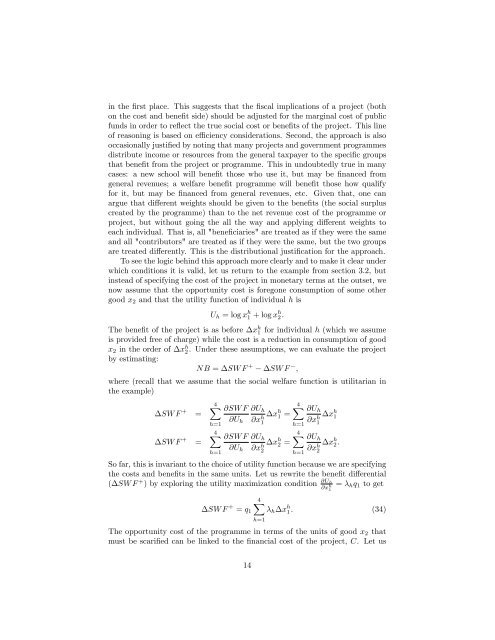Lecture Note 15: Social Cost Benefit Analysis - University of ...
Lecture Note 15: Social Cost Benefit Analysis - University of ...
Lecture Note 15: Social Cost Benefit Analysis - University of ...
You also want an ePaper? Increase the reach of your titles
YUMPU automatically turns print PDFs into web optimized ePapers that Google loves.
in the …rst place. This suggests that the …scal implications <strong>of</strong> a project (both<br />
on the cost and bene…t side) should be adjusted for the marginal cost <strong>of</strong> public<br />
funds in order to re‡ect the true social cost or bene…ts <strong>of</strong> the project. This line<br />
<strong>of</strong> reasoning is based on e¢ ciency considerations. Second, the approach is also<br />
occasionally justi…ed by noting that many projects and government programmes<br />
distribute income or resources from the general taxpayer to the speci…c groups<br />
that bene…t from the project or programme. This in undoubtedly true in many<br />
cases: a new school will bene…t those who use it, but may be …nanced from<br />
general revenues; a welfare bene…t programme will bene…t those how qualify<br />
for it, but may be …nanced from general revenues, etc. Given that, one can<br />
argue that di¤erent weights should be given to the bene…ts (the social surplus<br />
created by the programme) than to the net revenue cost <strong>of</strong> the programme or<br />
project, but without going the all the way and applying di¤erent weights to<br />
each individual. That is, all "bene…ciaries" are treated as if they were the same<br />
and all "contributors" are treated as if they were the same, but the two groups<br />
are treated di¤erently. This is the distributional justi…cation for the approach.<br />
To see the logic behind this approach more clearly and to make it clear under<br />
which conditions it is valid, let us return to the example from section 3.2, but<br />
instead <strong>of</strong> specifying the cost <strong>of</strong> the project in monetary terms at the outset, we<br />
now assume that the opportunity cost is foregone consumption <strong>of</strong> some other<br />
good x2 and that the utility function <strong>of</strong> individual h is<br />
Uh = log x h 1 + log x h 2:<br />
The bene…t <strong>of</strong> the project is as before x h 1 for individual h (which we assume<br />
is provided free <strong>of</strong> charge) while the cost is a reduction in consumption <strong>of</strong> good<br />
x2 in the order <strong>of</strong> x h 2. Under these assumptions, we can evaluate the project<br />
by estimating:<br />
NB = SW F +<br />
SW F ;<br />
where (recall that we assume that the social welfare function is utilitarian in<br />
the example)<br />
SW F + =<br />
SW F + =<br />
4X @SW F<br />
h=1<br />
@Uh<br />
4X @SW F<br />
h=1<br />
@Uh<br />
@Uh<br />
@x h 1<br />
@Uh<br />
@x h 2<br />
x h 1 =<br />
x h 2 =<br />
4X<br />
h=1<br />
4X<br />
h=1<br />
@Uh<br />
@x h 1<br />
@Uh<br />
@x h 2<br />
So far, this is invariant to the choice <strong>of</strong> utility function because we are specifying<br />
the costs and bene…ts in the same units. Let us rewrite the bene…t di¤erential<br />
= hq1 to get<br />
( SW F + ) by exploring the utility maximization condition @Uh<br />
@x h 1<br />
SW F + = q1<br />
4X<br />
h=1<br />
x h 1<br />
x h 2:<br />
h x h 1: (34)<br />
The opportunity cost <strong>of</strong> the programme in terms <strong>of</strong> the units <strong>of</strong> good x2 that<br />
must be scari…ed can be linked to the …nancial cost <strong>of</strong> the project, C. Let us<br />
14


